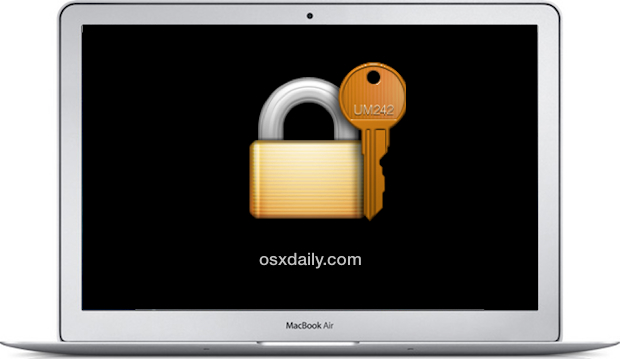Easy and Useful Tips to Help Secure Your Mac

It’s a good idea to secure your Mac from prying eyes, and it doesn’t take a lot of work to set some basic security to Mac OS X. This will help protect a Mac and the important files you have on it, and I consider the following three tips to be 100% necessary for almost all Mac users, particularly if you’re either in a shared computing environment, an office, school, public place, and especially if you have a laptop.
Each of these three security tricks can be enabled via the System Preferences with the Account pane and the Security pane, respectively. What you’re going to be doing is requiring a password if the computer is woken from a ‘sleep’ state, including a screen saver, and also preventing the automatic login process, thus requiring a password to be entered if a Mac has been booted up or restarted. Finally, you’ll learn a simple keystroke to lockdown everything anytime you step away from the computer, thereby increasing the protection by restricting access.
Don’t worry if you’re not sure where to begin, we will walk you through the simple steps and you’ll have some added protection and security added to your Mac in just a few minutes.
1: Secure your Mac by requiring password upon wake from sleep or screensaver
Always password protect your Mac! The basic way to do this is through the Security preference panel in OS X. This method will make sure that a password must be entered before a Mac can be used if it’s woken from sleep or woken from a screen saver:
- Go to Apple Menu > System Preferences > Security
- Click on General section
- Enable password prompt to wake computer from sleep or screen saver, which is done by clicking the first checkbox
2: Disable Automatic Login to Secure User Accounts
This means that a Mac that is rebooted or booted fresh must require a full login before the computer can be used. This is basically a method of protecting against someone rebooting a Mac to bypass the first tip of a screen saver password.
- Go to Apple Menu > System Preferences > Accounts
- Click on the Lock to make changes
- Choose Login Options
- Disable automatic login, so strangers will require password to access into your Mac
Seriously, set these passwords, it’s a good idea for so many reasons. Secure your Mac!
3: Stepping Away From Your Mac? Remember To Lock The Screen
After you set up the screen saver password you can now lock the Mac’s screen with a keyboard shortcut or hot corner, do this every time you step away from a Mac!
- New Macs: Hit Control+Shift and the “Power” button to initiate the lockdown immediately
- Older Macs: Hit+Control+Shift and the “Eject” button to initiate the screen lock
If your Mac has an eject key it’s a bit older, whereas the Macs without one are newer.
So, those are the three simple tips and they should be used on all Macs regardless of user knowledge of computing and OS X. For those who are comfortable with more advanced protective mechanisms, strongly consider using FileVault disk encryption to not only lock a Mac, but also individually encrypt each individual file and folder on the computer. FileVault is so secure that it’s virtually impenetrable without the password, which makes it excellent for protecting a Mac, but not for those who are prone to forget their passwords!


i’m glad you wrote this up because i did not know how to secure my mac previously and i always wanted to stop my roommates from using my mac when i am gone and the screensaver tip is the perfect solution. thanksss